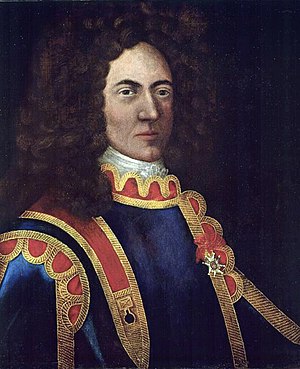Raid on Deerfield
| Raid on Deerfield | |||||||
|---|---|---|---|---|---|---|---|
| Part of Queen Anne's War | |||||||
 Jean-Baptiste Hertel de Rouville - French Commander |
|||||||
|
|||||||
| Belligerents | |||||||
|
|
Abenaki Iroquois Wyandot Pocumtuc Pennacook |
||||||
| Commanders and leaders | |||||||
| Jonathan Wells |
Jean-Baptiste Hertel de Rouville Wattanummon |
||||||
| Strength | |||||||
| 20 outside militia 70 town militia |
240 Indians 48 Frenchmen |
||||||
| Casualties and losses | |||||||
|
Raid: 56 killed, 112 captured |
reports vary; 10–40 killed | ||||||
| The total number of people inside the palisade at the time of the attack was 291 people. In addition to the villagers, this included the 20 outside militia and 3 French traders. | |||||||
Raid: 56 killed, 112 captured
Villagers: 44 killed (10 men, 9 women, 25 children), 109 captured
The 1704 Raid on Deerfield (or the Deerfield Massacre) occurred during Queen Anne's War on February 29 when French and Native American forces under the command of Jean-Baptiste Hertel de Rouville attacked the English frontier settlement at Deerfield, Massachusetts, just before dawn, burning part of the town, killing 47 villagers, and taking 112 settlers captive to Canada, of whom 60 were later redeemed.
Typical of the small scale frontier conflict in Queen Anne's War, the French-led raid relied on a coalition of French soldiers and a variety of Indian populations, including in the force of about 300 a number of Pocumtucs who had once lived in the Deerfield area. The diversity of personnel, motivations, and material objectives involved in the raid meant that it did not achieve full surprise when they entered the palisaded village. The defenders of some fortified houses in the village successfully held off the raiders until arriving reinforcements prompted their retreat. However, the raid was a clear victory for the French coalition that aimed to take captives and unsettle English colonial frontier society. More than 100 captives were taken, and about 40 percent of the village houses were destroyed.
Although predicted, the raid shocked New England colonists, further antagonized relations with the French and their Native American allies, and led to more community war preparedness in frontier settlements. The raid has been immortalized as a part of the early American frontier story, principally due to the account of one of its captives, the Rev. John Williams. He and his family were forced to make the long overland journey to Canada. His young daughter Eunice was adopted by a Mohawk family; she became assimilated and married a Mohawk man. Williams' account, The Redeemed Captive, was published in 1707 and was widely popular in the colonies.
...
Wikipedia
